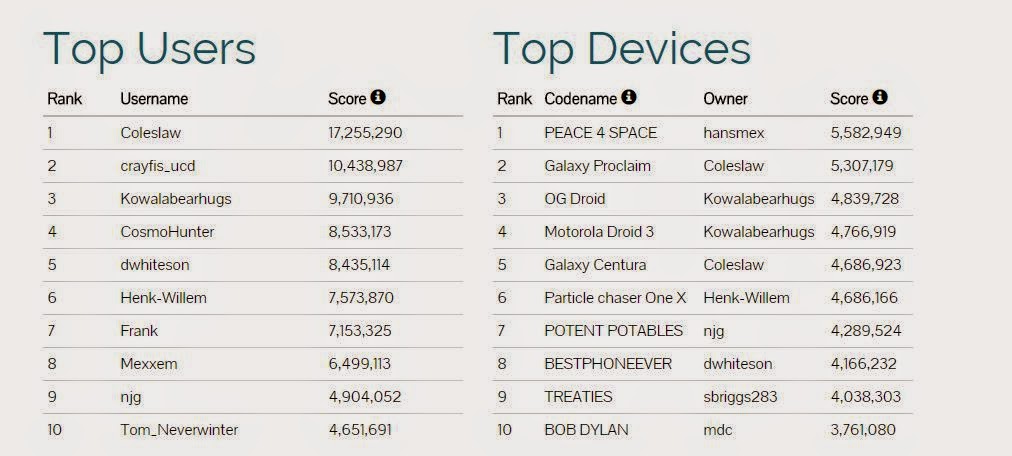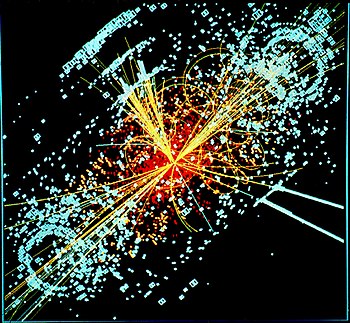603
References:
Daniel Whiteson, Michael Mulhearn, Chase Shimmin, Kyle Brodie, & Dustin Burns (2014). Observing Ultra-High Energy Cosmic Rays with Smartphones Instrumentation and Methods for Astrophysics arXiv: 1410.2895v1
| An example of simulated data modelled for the CMS particle detector on the Large Hadron Collider (LHC) at CERN. Here, following a collision of two protons, a is produced which decays into two jets of hadrons and two electrons. The lines represent the possible paths of particles produced by the proton-proton collision in the detector while the energy these particles deposit is shown in blue. (Photo credit: Wikipedia) |
As the Large Hadron Collider (LHC) is fired up for its round two of investigations by CERN, the scientific community waits for fresh findings from the single largest machine ever built by mankind. The last time, the LHC was fired up, it was able to generate substantial data to show that the Higgs Boson was not just a theorized particle but something that actually existed inside an atom. Naturally, hopes from this massive particle accelerator are huge and in the past two years, the machine has been armed to accelerate particles twice as fast and there are some serious answers expected to our doubts about the Standard Model and the moments just after the Big Bang!
If you would like somebody to explain the standard model to you as if you were a 5th grader, then you should read Jonathan Caroll’s Explainer on The Conversation. But for those who like simpler things, here is the good news. Unlike the massive machine that CERN built over 10 years near Geneva, to detect particles that exist in our universe, each one of us is capable of finding out about these particles, whether we understand the complex physics or not. Its just that we are not aware of it! All one needs is a smartphone.
While the focus of the Large Hadron Collider has been its sheer size, capability of accelerating particles to high speeds and making them clash, the most important components of the device are actually the Seven detectors that have been placed along the circular track of accelerating particles which detect the remnants of the collision and capture all the data for us. It is these detectors that are the heroes of the entire experiment being conducted by CERN, the silent observers of the entire process. But a camera in a smartphone is equally capable of detecting such particles, provided we know how to use it.
High energy particles originate from cosmic rays that strike the Earth’s atmosphere and span several kilometres across in the sky. (You can read more about these mysterious cosmic rays from the Pierre Auger Observatory website ). A very large detector would be required to detect these high energy particles. Researchers Daniel Whiteson and his colleagues at the University of California, hypothesize that the CMOS sensor of a smartphone is capable of detecting high energy particles in the atmosphere. But since the size of the sensor is quite small, it would not be able to cover the large area span of these particles. This disadvantage can be offset by using many small smartphone sensors lined up together to form an array of smartphone sensors. But would you be willing to donate your smartphone for such a scientific experiment? Actually, you do not have to because there is an app for that!
Once installed, the Crayfis (Cosmic Rays Found In Smartphones) App collects this data for you by using the camera sensor and uploads it to the database using the Wi-Fi connection on the phone. The app has been designed to use the phone’s idle time such as when it is plugged in, charging and not being used by you, to ensure that your usage of the phone is not hampered in any way. Besides, you are given a score for your contribution to the data collected and you can even make it to the leader board like the guys below have!
High energy particles originate from cosmic rays that strike the Earth’s atmosphere and span several kilometres across in the sky. (You can read more about these mysterious cosmic rays from the Pierre Auger Observatory website ). A very large detector would be required to detect these high energy particles. Researchers Daniel Whiteson and his colleagues at the University of California, hypothesize that the CMOS sensor of a smartphone is capable of detecting high energy particles in the atmosphere. But since the size of the sensor is quite small, it would not be able to cover the large area span of these particles. This disadvantage can be offset by using many small smartphone sensors lined up together to form an array of smartphone sensors. But would you be willing to donate your smartphone for such a scientific experiment? Actually, you do not have to because there is an app for that!
Once installed, the Crayfis (Cosmic Rays Found In Smartphones) App collects this data for you by using the camera sensor and uploads it to the database using the Wi-Fi connection on the phone. The app has been designed to use the phone’s idle time such as when it is plugged in, charging and not being used by you, to ensure that your usage of the phone is not hampered in any way. Besides, you are given a score for your contribution to the data collected and you can even make it to the leader board like the guys below have!
 |
| Leader board of users and devices participating in the Crayfis experiment. If your phone captures valuable data, you will become an author of a scientific paper! Photo Credit: www.crayfis.io/map |
The only issue is that Crayfis App is currently in beta testing and not available to all. If you would like to sign up for this experiment and get yourself a scientific paper, then you can visit CRAYFIS website and register your interest. Alternatively, you can just subscribe to our blog and we will keep you posted as soon as the app is available for all.
Since there are more than a billion smartphones being used in the world currently, collectively the camera sensors make up a massive array of detectors that will capture data about these particles, much alike the Large Hadron Collider. So, although, it is not exactly a Hadron Collider in each phone, collectively all smartphones can do the same work that the Large Hadron Collider is aiming for in Geneva.
For those who knew that it wasn’t really a hadron collider in every smartphone, then Kudos to you. But we would like to know at what stage of this post, did you become aware of this fact.
A) At the very beginning of the article.
B) Mid way through the article.
C) Had absolutely no clue till the end.
You can simply write A, B or C in the comments section below and probably a little background information about yourself, such as whether you have a scientific background or you are just a science enthusiast!
References:
Daniel Whiteson, Michael Mulhearn, Chase Shimmin, Kyle Brodie, & Dustin Burns (2014). Observing Ultra-High Energy Cosmic Rays with Smartphones Instrumentation and Methods for Astrophysics arXiv: 1410.2895v1





